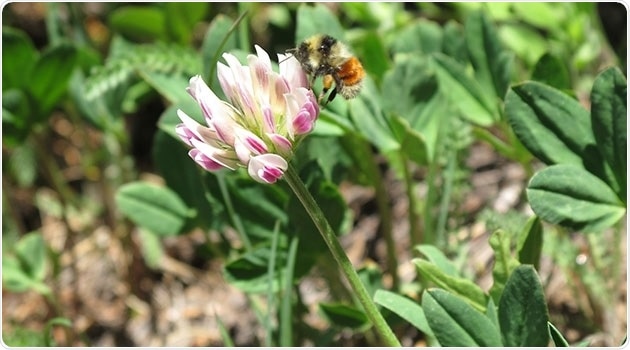Scientists at Uppsala University have discovered a new species of bumblebees while investigating genetic diversity in bumblebees in the Rocky Mountains, United States. They have given the name Bombus incognitus to the new species and have reported the study results in the Molecular Biology and Evolution journal.

The newly discovered Bombus incognitus looks identical to another species, Bombus sylvicola. It is impossible to say which one of the two is seen in this photo. Image Credit: Jennifer Geib.
Bumblebees are crucial not just for agriculture but also for the natural world, thanks to their role in plant pollination. Over 250 species of bumblebee exist, and they can be found mainly in Earth’s northern temperate regions.
Disturbingly, several species are vanishing because of the influences of climate change, with those from arctic and alpine habitats specifically endangered. But the complete diversity of bumblebee species in such environments is still not known.
Hundreds of samples
A group of researchers from Uppsala University led by Matthew Webster, along with collaborators in the United States, investigated genetic diversity in bumblebees in the Rocky Mountains, Colorado, by accumulating hundreds of samples and sequencing their genomes.
Strikingly, the data showed the existence of a new species, which could not be differentiated in appearance to the species Bombus sylvicola, but evidently different at the genetic level. The researchers named this species Bombus incognitus.
The researchers compared the Bombus sylvicola and Bombus incognitus genomes, thereby learning about how the new species formed. They identified signals consistent with gene flow between the species at the time of their evolution.
Moreover, they found parts of chromosomes that were incompatible between both the species, which serve as genetic barriers to gene flow and were possibly crucial in making both the species separate.
Larger number of bumblebee species?
These findings suggest that the number of bumblebee species in alpine and arctic environments may be larger than considered earlier. Another possibility is that mountainous terrain is conducive to speciation.
Populations adapted to cold could become isolated at high altitudes during warming periods in their evolutionary history, resulting in the formation of new species. One more possibility is that additional genome sequencing of bumblebees will uncover even more cryptic species that have been unidentified until now.
Source:
Journal reference:
Christmas, M. J., et al. (2021) Genetic barriers to historical gene flow between cryptic species of alpine bumblebees revealed by comparative population genomics. Molecular Biology and Evolution. doi.org/10.1093/molbev/msab086.